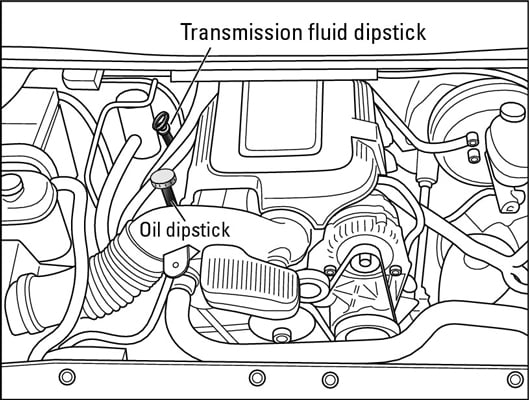As an Amazon Associate, I earn from qualifying purchases at no extra cost to you.
How to Master Checking Automatic Transmission Fluid Level
To check the automatic transmission fluid level, locate the transmission dipstick, remove it, wipe it clean, reinsert it fully, and then remove it again to see the level on the dipstick. You can easily maintain your vehicle’s transmission system by regularly checking the fluid level and adding more fluid, if necessary.
Proper levels ensure smooth gear shifts, heat regulation, and overall transmission performance. Neglecting this maintenance task may result in transmission damage or failure, leading to expensive repairs. By monitoring the transmission fluid level, you can prolong the lifespan of your car’s transmission system and avoid costly repairs in the future.
Why Checking Automatic Transmission Fluid Level Is Important
Checking the automatic transmission fluid level is crucial for your vehicle’s overall performance and longevity. Follow these steps to ensure your transmission is properly lubricated and working efficiently.
Ensuring the proper functioning of your vehicle’s automatic transmission is essential for a smooth and safe driving experience. One crucial aspect of maintaining the health of your transmission is regularly checking the automatic transmission fluid (ATF) level. Ignoring this simple but crucial task can lead to serious issues and costly repairs down the line. Let’s explore why checking automatic transmission fluid level is so important.
Ensures Proper Transmission Function
Ensuring the automatic transmission fluid level is within the recommended range is vital to ensure the proper function of your vehicle’s transmission. ATF serves several crucial purposes in an automatic transmission, including lubricating the moving parts, preventing excessive wear and tear, and transferring power between the engine and the wheels. Maintaining the proper ATF level helps to keep these components properly lubricated, reducing friction and heat buildup. This ultimately results in smooth gear shifts, improved performance, and a longer lifespan for your transmission.
Prevents Costly Repairs
Regularly checking the automatic transmission fluid level can also help prevent costly repairs in the future. Insufficient or contaminated ATF can lead to accelerated wear and damage to various transmission components, such as clutches, valves, seals, and gaskets. Without proper lubrication and cooling, these parts may overheat and fail prematurely, leading to expensive repairs or even a complete transmission replacement. By simply checking the ATF level and topping it up or replacing it when necessary, you can help avoid these unnecessary expenses and prolong the life of your transmission.
Don’t overlook the importance of checking your vehicle’s automatic transmission fluid level. By doing so regularly, you can ensure proper transmission function and prevent costly repairs. Remember, a little maintenance and attention today can save you from major headaches tomorrow!

Credit: www.nissanrva.com
Step-by-step Guide To Checking The Automatic Transmission Fluid Level
Step-by-Step Guide to Checking the Automatic Transmission Fluid Level
Checking the automatic transmission fluid level is an essential maintenance task that every vehicle owner should know. Properly maintained transmission fluid ensures smooth gear shifting and enhances the overall lifespan of the transmission system. In this step-by-step guide, we will walk you through the process of checking the automatic transmission fluid level in your vehicle.
1. Park The Vehicle On A Level Surface
Before checking the transmission fluid level, ensure that your vehicle is parked on a level surface. This ensures accurate readings and prevents any mishaps while performing the task. If necessary, use a leveling tool or find a level parking area to ensure the accuracy of your measurements.
2. Locate The Transmission Fluid Dipstick
The transmission fluid dipstick is usually located near the back of the engine compartment. It is typically easy to identify, as it has a bright-colored handle, such as yellow or red. Look for the dipstick labeled “Transmission” or consult the vehicle’s owner manual for its exact location.
3. Check The Fluid Level
Once you have located the dipstick, follow these steps to check the automatic transmission fluid level:
- With the engine warmed up and running, shift the transmission through each gear position, pausing briefly in each one before returning it to park.
- With the engine idling and the transmission in park, carefully remove the dipstick from its tube.
- Wipe the dipstick clean with a lint-free cloth or paper towel.
- Reinsert the dipstick fully back into the tube, then remove it again to check the fluid level.
Ensure that the fluid on the dipstick reaches the appropriate marking for the transmission fluid level. The marking may vary depending on the vehicle make and model, so refer to the owner’s manual for specific instructions. If the fluid level is below the “Add” or “Cold” marking, you need to add more transmission fluid. If it’s above the “Full” or “Hot” marking, you may have excess fluid, which can also cause issues.
Regularly checking and maintaining the automatic transmission fluid level is crucial for the overall performance and longevity of your vehicle’s transmission system. By following these simple steps, you can ensure that your transmission has the proper fluid level, allowing for smooth gear shifting and minimizing the risk of costly repairs in the future.
Interpreting The Automatic Transmission Fluid Level Reading
When it comes to ensuring the smooth operation of your vehicle’s automatic transmission, regularly checking the transmission fluid level is crucial. Understanding how to interpret the readings can help you identify any issues and take the necessary steps to maintain your transmission’s performance. In this section, we will discuss how to interpret the automatic transmission fluid level reading and what each reading signifies.
Reading Below The Minimum Level
If the automatic transmission fluid level is below the minimum level, it indicates that there is a potential problem with your transmission and immediate action is required. Driving with insufficient fluid can lead to overheating, increased friction, and damage to the transmission components.
If you find that the fluid level is below the minimum, follow these steps to rectify the issue:
- Locate the transmission dipstick. It is usually labeled and has a distinctive handle.
- Remove the dipstick and wipe it clean using a lint-free cloth.
- Insert the dipstick back into the tube fully and then remove it again.
- Check the fluid level against the markings on the dipstick.
- If the fluid level is below the minimum mark, add the appropriate transmission fluid recommended by the manufacturer.
- Recheck the fluid level to ensure it is now within the acceptable range.
Reading Between The Minimum And Maximum Levels
If the automatic transmission fluid level falls within the range marked between the minimum and maximum levels on the dipstick, your transmission is functioning properly. However, it is still important to monitor the fluid level regularly to ensure it remains within this optimal range.
To maintain the transmission fluid level within the acceptable range, follow these steps:
- Inspect the fluid regularly to identify any noticeable changes in color, consistency, or odor.
- If any abnormalities are detected, such as a burnt smell or a dark and murky appearance, it may indicate a potential issue with the transmission. In such cases, it is advisable to consult a qualified mechanic.
- If no abnormalities are present, you can be confident that your transmission is in good condition.
Reading Above The Maximum Level
Reading above the maximum level on the transmission dipstick suggests an overfilling of fluid, which can cause damage to the transmission and reduce its effectiveness. It is essential to address this issue promptly.
If you discover that the fluid level is above the maximum mark, follow these steps to resolve the problem:
- Safely drain excess fluid from the transmission until it falls within the acceptable range.
- If you are unsure how to do this, seek the assistance of a certified mechanic or refer to the vehicle’s owner’s manual for guidance.
- Once the fluid level is within the acceptable range, monitor it regularly to ensure it remains stable.
Regularly checking the automatic transmission fluid level and interpreting the readings correctly is vital for the longevity and performance of your vehicle. By following these guidelines, you can avoid potential transmission issues and maintain a smooth driving experience.

Credit: www.dummies.com
Additional Tips And Considerations
When it comes to checking the automatic transmission fluid (ATF) level in your vehicle, there are a few additional tips and considerations that can help you ensure that your transmission is functioning properly. Following these recommendations can save you both time and money in the long run.
Follow Manufacturer’s Recommendations
It is crucial to refer to your vehicle’s manufacturer manual to determine the specific ATF type and the recommended procedure for checking the fluid level. Different vehicles may require different types of ATF, and the level may be checked while the engine is running or at a specific temperature. Following the manufacturer’s guidelines guarantees accuracy and prevents potential damage.
Check Transmission Fluid Quality And Condition
While checking the ATF level, it is equally important to inspect the fluid quality and condition. Transmission fluid should be transparent, with a reddish hue and a slightly sweet smell. If the fluid appears dark or smells burnt, it may indicate contamination or internal wear. In such cases, it is advisable to replace the fluid and consult with a professional technician to investigate any underlying issues.
Consider Professional Assistance
If you are uncertain about checking the ATF level or encounter any abnormalities during the process, it is recommended to seek professional assistance. Certified technicians have the expertise and tools necessary to accurately inspect and service your transmission. Addressing any potential issues promptly can prevent extensive damage and costly repairs in the future.
By adhering to these additional tips and considerations, you can effectively maintain your vehicle’s automatic transmission and ensure its optimal performance for the long haul.

Credit: www.mobil.com
Frequently Asked Questions For How To Check Automatic Transmission Fluid Level
Do You Check Automatic Transmission Fluid With The Engine Running?
Yes, it is important to check the automatic transmission fluid with the engine running to get accurate readings.
What Is The Correct Way To Check Transmission Fluid Level?
To check transmission fluid level, park your car on a level surface and let the engine run. Locate the transmission dipstick, usually near the engine. Remove it, wipe it clean, reinsert fully, and remove again to get an accurate reading.
The fluid level should be between the marked lines on the dipstick.
Do You Check Transmission Fluid In Park Or Neutral?
You should check the transmission fluid in park.
How Do I Know If My Car Needs Automatic Transmission Fluid?
Check the vehicle’s manual or contact a professional for guidance on when to change automatic transmission fluid. Regular maintenance and signs of trouble such as slipping gears or a burnt smell could indicate the fluid needs attention. Keep an eye on fluid levels and color for any abnormalities.
How Do I Check The Automatic Transmission Fluid Level On My Car?
To check the automatic transmission fluid level on your car, locate the transmission dipstick, remove it, wipe it clean, reinsert it, and then remove it again to observe the fluid level.
Why Is It Important To Check The Automatic Transmission Fluid Level Regularly?
Regularly checking the automatic transmission fluid level is important as it ensures optimal performance, prevents potential damage to the transmission, and helps identify any potential issues early on.
What Can Happen If The Automatic Transmission Fluid Level Is Too Low?
If the automatic transmission fluid level is too low, it can lead to poor shifting, overheating, increased wear and tear on the transmission components, and potential transmission failure.
How Often Should I Check The Automatic Transmission Fluid Level?
It is recommended to check the automatic transmission fluid level at least once every month or as per the manufacturer’s guidelines to ensure proper maintenance of your vehicle.
Conclusion
To sum it up, checking the automatic transmission fluid level is a crucial maintenance task that should not be overlooked. By following the simple steps outlined in this blog post, you can ensure optimal performance and longevity of your vehicle’s transmission.
Regularly monitoring the fluid level will not only prevent potential issues but also save you from costly repairs in the long run. So take the time to check your transmission fluid and keep your vehicle running smoothly.


